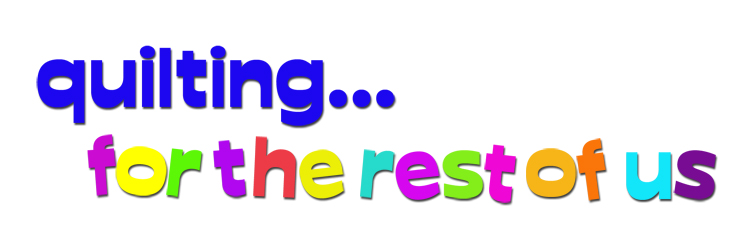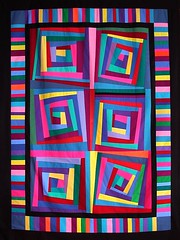I have been pondering this for awhile, and decided this morning I'd write a blog post about launching a "Slow Quilting Movement," with a nod to the Slow Food Movement. Before I sat to write, though, I did a quick Google and came across this blog post,
Slow Quilting, stating some of what I'm feeling. So kudos to Andi Reynolds for her words that so closely resonate with my own thoughts, although her emphasis is on hand-piecing, which is not on my radar screen at this point. But still...
One of my resolutions for 2012 is to do a slow quilt. (For those of you who are listeners and are considering entering my
2012 Quilty Resolutions giveaway, this is my personal goal for #2, "The project I've always wanted to do but...."). I've been feeling this nudge for awhile--probably about a year. Here's the backstory; I imagine it's a story that's shared with many of my readers and listeners.
For many years of my quilting life, I've been emphasizing "fast and easy," mostly due to a lack of time. When my kids were little-r, with the job and travel that I have, my quilting life was very much catch-as-catch-can. Finding a few minutes here and there between playing taxi, sitting in doctor's waiting rooms (moms seem to do an inordinate amount of that, don't we?), running multiple pets to the vet...oh, and working full time and periodically hopping on airplanes...meant that my quilting emphasis was on quick gratification. What would I be able to actually accomplish in short periods of time, so I could get something pretty on the wall or to cuddle under? What would give me fast results and that sense of satisfaction of a job well done? (Or, in my case, at least decently-well done.)
Once my kids became less-little-r and largely didn't need me around on a moment-to-moment basis--and had their own wheels and the ability to, as young adults, get themselves to their own dang doctor appointments, thank you very much--I then entered a period that I think of as, "Wheee!!" Suddenly I could spend a whole lot more time in my sewing room and I started cranking out all those quilt projects that had lived in my head for so long. I felt so much accomplishment as I watched the UFOs being finished, as I got a lot more wallhangings on my walls, as I gave away more gifts, as I worked on donation quilts (unfortunate or otherwise). I also started looking for fast ways to use stash--all these pretty pretty fabrics I'd bought but never really had the time to do anything with. Reading other folks talk about their accumulated projects urged me on--Whee! Look how much I could accomplish, too!
Now, though, I'm feeling myself with a strong desire to put on the brakes. I've loved every minute of the frenzy, mind you. There's nothing wrong with the frenzy. But now I want to slow down and focus. I want to engage in a single project that I'll live with from beginning to end. I'll dream it in my head first. I want it to have meaning, symbolism, some connection with the rest of my life. Then I'll spend time planning it out--but not too much planning, because I want to give it space to breathe as well, and become whatever it decides it wants to become as I live with it through time. I want to do a few things, then let it rest, then come back and do a few more things as it speaks to me, then let it rest some more.
I'm not going to say that I want time to "enjoy the process," because I've always enjoyed the process. I just think I'm looking for a slightly different process. And this is different from the UFO that gets set aside as distraction or frustration or other obligations set in. This is something kept in the forefront of my mind and consistently poked away at, but without a specific deadline or even, necessarily, the sense of obligation of, "I must finish this!" More, I'm looking for what will make me feel like it's finished whenever it says it is. I want to give a quilt the space to talk to me.
There were times that I had to rush my little-r kids through bathing and dressing and getting out the door for some appointment or another. And then there were the times that we just hung out, that we could just "be." And in that "be" time, they were still growing, and learning, and becoming. Not to get too metaphorical about it, but that's what I'm looking for in a quilt. I want "be" time.
So my second resolution for 2012 is to work on a Slow Quilt. What do you think? Are you feeling the same urge? Should we launch a Slow Quilt Movement? (Actually, it was launched hundreds of years ago and there are still folks out there that practice it quite intentionally. It's just gotten largely lost on the Internet, I suspect.) I'll be doing fast-n-easy projects and UFOs and such in the middle of that, too--there is still a lot of benefit to that! I just want one project to feel like it's part of my life for a prolonged period of time, in a good way.
For those of you who are curious about what my other two resolutions are, referencing back to the
2012 Quilty Resolutions giveaway:
My first resolution, "Something New I Will Try," is actually two-fold: y-seams and curved piecing. It's a sign of how much I've been immersed in the Fast Quilt movement that I've been quiltmaking for as long as I have and have managed to avoid either of those. I'm not at all worried about either of them, I just need to actually do them. Hexies, I'm coming!
My third resolution, "The One UFO I'm Committed to Finishing," is my warm color challenge wall-hanging. Poor dear has been hanging on my design wall for months, set aside as I got hooked into trying to finish up Christmas gift quilts. Your time will soon come, honey.
So that's it. If you're thinking you might want to be part of a Slow Quilt Movement, let's sometimes hashtag #SQM on Twitter or something. Usually we encourage each other on to an end--but this time, maybe we'll be encouraging each other in the opposite direction: "Woah, there, sister! Sure you want to finish yet?"
 OK, so with all my themed blogging days I may have been able to sneak it by you that I haven't actually done any quiltmaking of my own lately. I could say it was because I was spending all my free time experimenting with oatmeal, but that's not exactly true. Well, a little true. But not that true.
OK, so with all my themed blogging days I may have been able to sneak it by you that I haven't actually done any quiltmaking of my own lately. I could say it was because I was spending all my free time experimenting with oatmeal, but that's not exactly true. Well, a little true. But not that true.






































